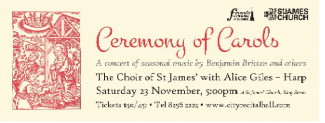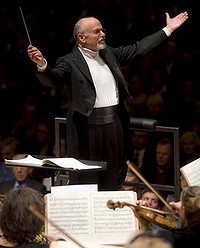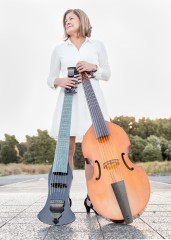Review: A Ceremony of Carols, The Choir of St James’ King Street

Ceremony of Carols
Choir of St James’ Church, King Street, Sydney
23 November 2013
Benjamin Britten was born on St Cecilia’s Day (22 November) 1913 and the Choir of St James’ Church celebrated his centenary with a concert focusing on his music. It provided a splendid conclusion to a year of fine performances under the choir’s admirable conductor Warren Trevelyan-Jones.
The programme opened with the delightful Hymn to St Cecilia – Britten’s own tribute to the patron saint of music. This was largely written on board ship in 1942 when Britten was returning from three years in the USA. It is unaccompanied so the voices are very exposed and the challenges of pitch and intonation were more apparent in this work than in the other pieces in the programme which had instrumental accompaniments. Trevelyan-Jones sought a lightness and transparency in the opening section but it may have benefited from more gentle accenting and sustained phrasing. Here, and throughout the concert, there were excellent solo contributions from members of the choir and Liza Lilli’s pure, bell-like soprano tones were ideal for this music.
Contrast was provided by the guest harpist Alice Giles playing the fugue and hymn from Britten’s Suite for Harp. These are virtuoso pieces which present an intriguing mixture of ancient music filtered through twentieth century ears. The last movement was a stirring performance of a set of variations on the Welsh hymn St Denio – Britten’s gesture to the dedicatee and original performer, the Welsh harpist Osian Ellis.
The first half of the concert concluded with an enjoyable performance of another of Britten’s wartime choral works, Rejoice in the Lamb in which the choir’s unanimity and crisp rhythms were especially impressive. The organ accompaniment was provided by Alistair Nelson who chose particularly evocative organ registrations. Once again the solos from the choir were impressive and the sustained legato singing from the tenor Owen Elsley was especially pleasing. The restrained ecstasy which Trevelyan-Jones obtained in the closing sections was also very effective.
The second half of the concert had a Christmas flavour. It started with the Ceremony of Carols, which was also written by Britten on his sea voyage back to England in 1942. Although intended for a choir of boy trebles, this performance by a small group of three voices per part retained the delicate chamber music quality which the work needs. The harp accompaniment was again sensitively played by Alice Giles whose interlude movement impressively displayed the large dynamic range of which the harp is capable. Again, the solos from the choir displayed the depth of talent of the individual members of the choir.
The English Christmas theme continued with Vaughan Williams’ Fantasia on Christmas Carols which was performed with an organ accompaniment again played by Alistair Nelson. The baritone solos which link the various sections of the work and provide a musical continuity were impressively sung by Rob Hansen who delivered them in exactly the right English cathedral style.
Trevelyan-Jones replaced the advertised selection of miscellaneous carols with a much more musically satisfying bracket of twentieth century works. It started with Britten’s Hymn to the Virgin, written when he was only 17. This was a fine performance, with the semi-chorus effectively placed backstage.
Trevelyan-Jones referred to the death of the English composer John Tavener just a fortnight previously and made a late decision to incorporate two of his works into the programme as a tribute. It was an inspired decision for the choir to sing Tavener’s Hymn to the Mother of God at the extreme east end of the church, gathered around the altar. Here, the singers stood under a gold mosaic apse which visually evoked the Byzantine setting which Tavener, a convert to the Orthodox Church, would have pictured for performing this work. But even more impressive was the change of acoustic which this produced, with a longer reverberation time approximating, as much as is possible in St James, the lush acoustics of traditional Byzantine churches. It was very effective.
The concert closed with a florid arrangement of Adeste Fideles for solo harp, Tavener’s The Lamb and Rutter’s Dormi Jesu. These brought to a conclusion a fine commemoration of Britten’s centenary with musically rewarding performances. It also reinforced the standing of the choir of St James as perhaps the finest in Sydney for this repertoire.
Finally, it should be noted that the printed programme contained a long and scholarly set of programme notes by the chorister Isabella Woods. These provided an excellent commentary on the works performed and much food for thought afterwards.
Larry Turner for SoundsLikeSydney©
Larry Turner has been singing in choirs for many years – both in Sydney and London. He is an avid attendee of operas and concerts, with an emphasis on vocal music. He particularly enjoys music from both the great a capella period and the baroque – especially the lesser-known works of Bach and Handel. He has written programme notes for Sydney Philharmonia, the Intervarsity Choral Festival and the Sydneian Bach Choir and is currently part of a team researching the history of Sydney Philharmonia for its forthcoming centenary.






